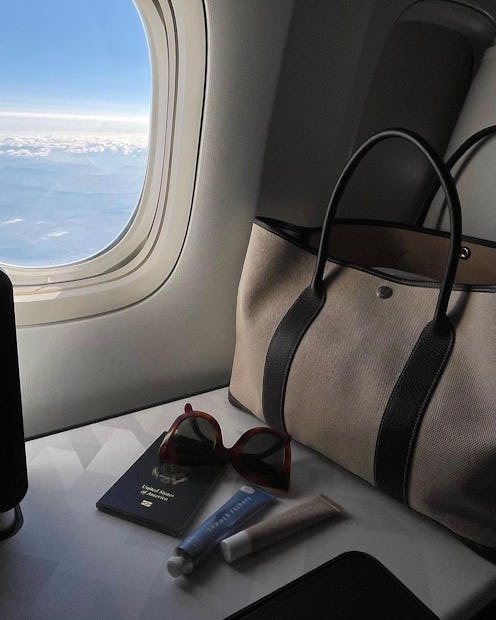(Skin)
The Right Way To Care For Your Skin Before, During, & After A Flight
Rack up miles, not breakouts.

It’s unclear when the shift happened, but when on a flight nowadays, it’s totally normal to glance over and see the person sitting next to you applying a full-blown multi-step skin care routine. You might even catch your seatmate taking a selfie while wearing their sheet mask or holding up a tube of moisturizer to the plane window for an aesthetic IG Story shot, complete with a poll prompting their followers to guess where they’re going. But is an airplane skin care routine really necessary or is it simply social media fodder?
According to Dr. Rebecca Marcus, MD, a board-certified dermatologist in Dallas, Texas, catching a flight does negatively impact your skin: “Flying exposes your skin to ultra dry air and increased levels of UV radiation present at high altitudes.” Therefore, it's extra important to take steps to protect your skin before takeoff.
However, when it comes to distinguishing what's necessary from what's just for the sake of appearing as if you have your life together, the answer really depends on a myriad of factors. Ahead, TZR spoke with three board-certified dermatologists to find out what you should be doing pre-, mid-, and post-flight, including how to modify your skin care routine so that you can travel in peace.
How To Take Care Of Your Skin Pre-Flight
There's a lot to keep track of before a flight, so it’s understandable that your skin care routine may not be at the top of your list, but it's actually quite simple. The key is to ensure that your skin is clean and well-hydrated before you board, as airplanes are known for their low humidity, which can be very drying. Additionally, the lower air pressure reduces oxygen flow, causing the skin to look more dull. “To combat these effects, it's essential to stock up on in-flight skin care ingredients such as hyaluronic acid, ceramides, and peptides, which provide extra hydration and skin barrier protection,” says Dr. Dendy Engelman, MD, a board-certified cosmetic dermatologist in New York City.
Dr. Marcus suggests starting with an antioxidant serum to combat free radicals, which can be damaging to the skin and lead to signs of aging such as fine lines and wrinkles. Follow this by applying an emollient cream to protect and reinforce the skin barrier, helping to lock in moisture during the flight.
Additionally, it's essential to apply a generous amount of sunscreen before flying. Dr. Marisa Garshick, MD, a board-certified dermatologist in New York City, advises that even prior to flying, applying sunscreen is crucial because “some UV rays can penetrate the windows of the aircraft and be even more potent at higher altitudes.” This helps protect your skin from the harmful effects of UV radiation during the flight. "Re-apply your SPF often, about every two hours, as at 30,000 feet, we are even closer to the sun, and plane windows do not fully protect against the harmful UVA rays," adds Dr. Engelman.
Pre-Flight Skin Care Products
How To Care For Your Skin Mid-Flight
The longer your skin is exposed to dry air, the more dehydrated it will become. If you're on a short flight, say one to three hours, you don't need to take your skin care out of your carry-on. However, if you're on an overnight flight, you may wish to use a cleansing wipe to remove any makeup and then reapply your serum, moisturizer, and sunscreen. “The longer a flight is, the more necessary it is to make sure to take a moment to re-apply your skin care routine, as typically any products that were applied prior to flying may have worn off,” says Dr. Garshick. This is even more important if you're sitting by a window for a long flight, especially if the shade is kept open.
When it comes to sheet masks, under-eye patches, or moisture masks, according to Dr. Marcus, whether or not you need to indulge depends on personal preference and your skin type. “I don't think it's a necessity, but if you enjoy it and it helps you, then do it,” she says. An in-flight skin care routine can also help mitigate some anxiety, whether travel-induced or not, as it can be a relaxing ritual that gives the illusion of control.
Those with oily skin may not need the extra hydration, but if your complexion leans dry, these masks may provide the hydration you’re craving. “Sheet masks can be a helpful way to boost hydration and reduce dullness during a long day of travel, but in general, it's always best to apply these to clean skin. For this reason, if you are going to use a sheet mask, always make sure to remove any makeup prior to use,” adds Dr. Garshick. And, of course, you're going to want to ensure that your hands are squeaky clean before touching your face.
How To Care For Your Skin Post-Flight
Once you hop off the plane, Dr. Engelman recommends double-cleansing and giving your skin some extra love as soon as you can to begin the recovery process.
“In general, after flying, one of the most important things you can do for your skin is to moisturize it to help boost hydration,” says Dr. Garshick. This may include applying a lip mask or ointment to help lock moisture into the lips, as well as thick hand and face creams.
Depending on the length of the flight, it can be helpful to wash your face and go about your normal skin care routine. For example, if you are arriving at your destination in the morning, it’s best to continue with your daily morning regimen. On the other hand, if your travel is at the end of the day, it’s important to wash your face to eliminate any buildup and then apply moisturizer to help replenish and nourish the skin.